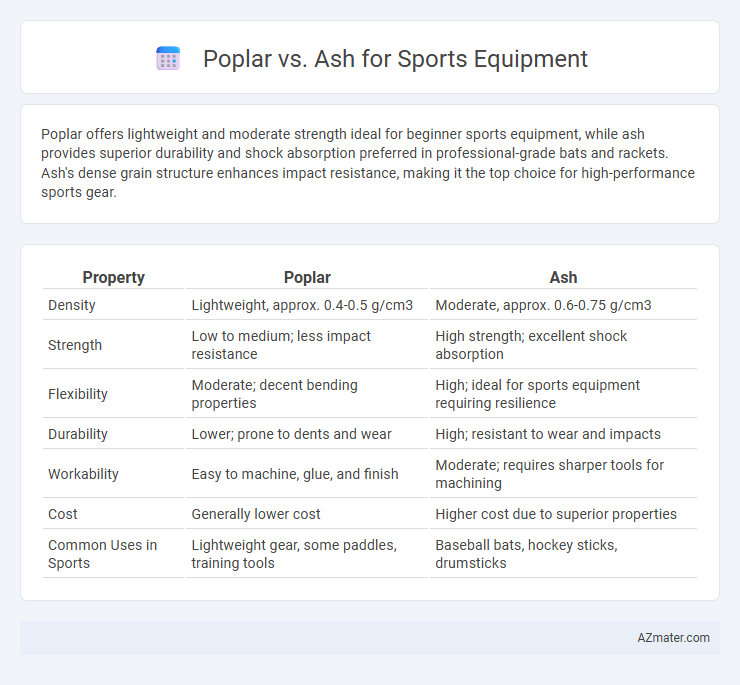Poplar offers lightweight and moderate strength ideal for beginner sports equipment, while ash provides superior durability and shock absorption preferred in professional-grade bats and rackets. Ash's dense grain structure enhances impact resistance, making it the top choice for high-performance sports gear.
Table of Comparison
| Property | Poplar | Ash |
|---|---|---|
| Density | Lightweight, approx. 0.4-0.5 g/cm3 | Moderate, approx. 0.6-0.75 g/cm3 |
| Strength | Low to medium; less impact resistance | High strength; excellent shock absorption |
| Flexibility | Moderate; decent bending properties | High; ideal for sports equipment requiring resilience |
| Durability | Lower; prone to dents and wear | High; resistant to wear and impacts |
| Workability | Easy to machine, glue, and finish | Moderate; requires sharper tools for machining |
| Cost | Generally lower cost | Higher cost due to superior properties |
| Common Uses in Sports | Lightweight gear, some paddles, training tools | Baseball bats, hockey sticks, drumsticks |
Overview of Poplar and Ash Woods
Poplar wood is lightweight and moderately hard, making it suitable for sports equipment that requires easy handling and moderate durability. Ash wood is renowned for its exceptional strength, shock resistance, and flexibility, qualities highly valued in sports gear like bats and rackets. Both woods offer unique performance characteristics, with ash preferred for impact-heavy applications and poplar favored for lighter, more agile equipment.
Physical Characteristics Comparison
Poplar wood is lightweight with a Janka hardness of around 540, making it softer and easier to shape compared to ash, which has a Janka hardness of approximately 1,320, providing greater durability and impact resistance. Ash features a straight grain and excellent elasticity, ideal for absorbing shocks in sports equipment like baseball bats, while poplar's fine, even texture offers good dimensional stability but less resilience under repeated stress. The higher density and tensile strength of ash contribute to superior performance and longevity in high-impact sports gear compared to the lighter, less robust poplar.
Weight and Density Differences
Poplar wood, known for its low density ranging from 0.4 to 0.5 g/cm3, offers a lightweight option for sports equipment, enhancing maneuverability and reducing fatigue. Ash, with a higher density of approximately 0.6 to 0.7 g/cm3, provides greater strength and impact resistance, ideal for durability in sports applications like baseball bats. The weight difference between poplar and ash directly influences equipment performance, where ash's heavier mass contributes to power and control, while poplar's lighter weight favors speed and ease of use.
Strength and Durability Analysis
Ash offers superior strength and durability compared to poplar, making it the preferred choice for sports equipment that requires impact resistance and long-term performance, such as baseball bats and hockey sticks. Poplar, while lighter and easier to work with, lacks the density and shock absorption properties of ash, resulting in lower resistance to wear and potential cracking under high stress. The cellular structure of ash wood provides enhanced flexibility and toughness, crucial for withstanding repetitive impacts in sports applications.
Flexibility and Shock Absorption
Poplar wood offers superior flexibility and moderate shock absorption, making it ideal for sports equipment requiring dynamic movement and controlled impact resistance. Ash wood provides excellent shock absorption and durability, suited for high-impact sports gear where vibration dampening is critical. Combining poplar's flexibility with ash's shock absorption creates a balanced performance in equipment like bats, paddles, and rackets.
Performance in Sports Applications
Poplar wood offers lightweight properties that enhance speed and agility in sports equipment such as baseball bats and hockey sticks. Ash provides superior shock absorption and durability, making it ideal for products requiring strength and impact resistance, like baseball bats and lacrosse sticks. The choice between poplar and ash depends on the balance needed between agility and power in specific sports applications.
Cost and Availability
Poplar sports equipment typically offers a lower cost due to its abundance and faster growth rate, making it widely available and budget-friendly for manufacturers. Ash, valued for its superior strength and shock resistance, tends to be more expensive and less plentiful, often resulting in higher prices and limited supply for specialized sports gear. The choice between poplar and ash hinges on balancing affordability with performance, where cost-sensitive projects favor poplar, while high-end equipment prioritizes ash's durability.
Popular Sports Equipment Made from Poplar
Poplar wood is widely used in the manufacturing of sports equipment such as baseball bats, skateboards, and hockey sticks due to its lightweight, strength, and shock absorption properties. Compared to ash, poplar offers greater flexibility and resistance to splitting, making it ideal for equipment requiring durability and impact resistance. Its popularity in producing beginner and mid-level sports gear stems from its cost-effectiveness and reliable performance.
Popular Sports Equipment Made from Ash
Ash wood is widely favored in sports equipment manufacturing due to its exceptional strength, flexibility, and shock resistance, making it a prime material for baseball bats, hockey sticks, and oars. Unlike poplar, which is lighter and less dense, ash offers superior durability and a solid feel, enhancing performance and control in high-impact sports. Its grain structure allows for precise shaping and consistent performance, solidifying ash as the preferred choice for professional-grade sports gear.
Choosing the Right Wood for Your Needs
Poplar offers lightweight characteristics and smooth grain, making it ideal for beginners seeking easy-to-handle sports equipment, while ash provides superior strength and shock resistance favored by professionals requiring durability. Ash's natural flexibility and ability to absorb impact make it the preferred choice for baseball bats and hockey sticks, ensuring optimal performance and longevity. Selecting the right wood depends on balancing weight, strength, and flexibility based on the specific sports equipment and user skill level.

Infographic: Poplar vs Ash for Sports Equipment
 azmater.com
azmater.com